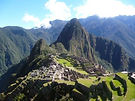PERU INFO
Home > About Peru > Peruvian identity
About Peru
Peru
Peruvian Identity
Republic of Peru
Government: Unitary presidential constitutional republic
President: José Pedro Castillo Terrones (since 2021)
Nacional day: July 28 - Independence day (1821).
The legislative branch is represented by a single-chamber Congress of 120 members, elected every 5 years (at the same time as the President).
Flag of Peru
It was created by General José de San Martín, the Argentine general liberators of Peru, who defined the colors of the flag. Landing in the Paracas bay (260 km - 160 mi south of Lima) on 8 September 1820 and watching the flight of the "parihuanas", a species of flamingos with a white body and red wings, inspired in the choice of these colors: red, white, red.
Flag adorned with the coat of arms appears only on public buildings. This emblem represent the richnesses of Peru in the three natural kingdoms:
The Vicuña - Animal kingdom – Representing the fauna of Peru, is one of four American camelids and the animal with the finest fiber in the world. 90% of vicuñas exist in America are in Peru.
The cinchona tree - Plant kingdom – Representing the national flora, origins from the Eastern Cordillera of Peru (limit with the Amazon rainforest) and its bark is used in medicine, it is the source of quinine, a powerful anti-malarial drug and the key flavorant in tonic water. The cinchona tree is one of the great discoveries of America.
Cornucopia with coins spilling from it - Mineral kingdom – represents the mineral resources of the country (gold, silver, copper, lead, zinc, etc.
The Coat of arms (Escudo de Armas) has a palm branch on its left and an laurel one on its right.
Tahuantinsuyo flag (Inca Empire)
The flag symbolizes the Tahuantinsuyo (Inca Empire) was created in 1973 by Raúl Montesinos, to commemorate the 25th anniversary of his radio and was officially adopted in 1978 by Gilberto Muñiz, the mayor of the city of Cusco. Montesinos was inspired by stories of Spanish chroniclers in colonial times, describing Inca banners with colors of the rainbow.
Today, a debate rages on the reality of this flag to the Inca period, some historians claiming that it is an invention of the twentieth century.
Nevertheless, many chroniclers of the sixteenth and seventeenth century wrote about "unanchas", a quechua word which can be translated as banners, describing in great detail the Inca flags such as Bernabé Cobo, in his book "History of the New World" (1609). Was also found drawings of multicolored flags painted on ceramics, paintings of the sixteenth century that represent Incas with their banners, etc.
Confusion with the gay pride flag
An almost identical flag was designed by Gilbert Backer in 1978 (the same year as the official adoption by the mayor of Cusco) for the gay community in San Francisco (USA). Originally there were 8 colors, the same as the inca flag more pink to symbolize the sexuality. Subsequently, pink and turquoise were removed and now with 6 colors (7 for the Tahuantinsuyo flag).
Administrative division
The country is divided into 24 departments (and 1 constitutional province, El Callao), divided into provinces and themselves divided into districts.
Largest cities:
Poblation of Peru
33,035,000 (estimated 2021)
Source: Instituto Nacional de Estadísticas e Informáticas INEI




